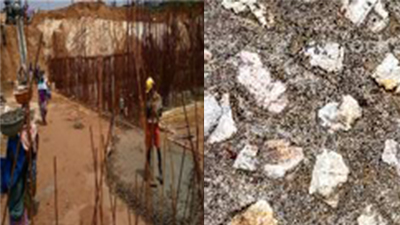Plum Concrete - A Cost-Effective Solution for Strong and Durable Structures
- Concrete Cost Estimator
- Concrete Continuous Footing
- Landscape Bidding and Estimating
- Construction Cost Estimating
- Concrete and steel cost estimation
- Construction Cost Estimate Breakdown
- Construction Estimating Worksheet
- Home Construction Cost Estimate
- Estimate Pricing Sheet
- Sheet for General Contractor
- Construction Cost Estimate
- Labor Materials Cost Estimator
- Masonry Estimating Sheet
- Sheet for Building Contractor
- Construction Schedule Bar chart
- General Cost Estimator Sheet
- General Construction Estimate
- Building and Road Estimating Sheet
- Detailed expense estimates
- Door and Window Takeoff Sheet
- General Construction Cost Estimating Sheet

Introduction
Plum concrete also known as PCC is a type of concrete mixture used in the construction of foundations and substructures.
Plum concrete has recently gained popularity due to some additional advantages over traditional concrete. Plum concrete provides better resistance to water and moisture which makes it an ideal form of concrete for structures which are exposed to such conditions. This article will cover everything about Plum concrete and how it is used in the construction industry.
What is Plum Concrete?
Plum concrete also known as PCC (plum concrete composite) is a mixture of coarse aggregates with sizes ranging from 80 to 150mm. these coarse aggregates are mixed in different ratios with cement, sand and water to form a mixture for different projects.
Plum concrete is used in structures where high strength and durability are required. the large size of the aggregates provides resistance to sheer and compressive force and makes it ideal for heavy-duty work like foundations, bridge abutments, etc.
Also Read : What is Mass Concrete?
Plum Concrete Ratio
The ratio of Plum concrete depends upon the project for which it is used. the ratio of different elements used in Plum concrete depends upon the desired strength and durability of the final product.
Generally, the following ratio is followed to make Plum concrete.
- Cement:Sand: Coarse Aggregates (stones or pebbles) = 1:2:3 to 1:3:5. For example, 1;2;3 means that for every part of cement, two parts of sand and three parts of aggregates are used in the mixture.
- The ratio that can be adjusted to achieve the desired result.
- Another thing that is to be noted is that, in the ratio of plum concrete, water plays an important role, the amount of water added will determine factors like workability, durability, cure time, etc.
Difference Between Plum Concrete and PCC
Plum concrete and PCC both are the same and are synonyms of one another. The term plum concrete is used to define a mixture of coarse aggregates, cement, and sand including or excluding water. the reason it is called "plum" concrete is that the term plum refers to the size and shape of the aggregates used in the mixture, the size of the aggregates ranges from 80mm to 150mm. Overall, plum concrete and PCC both are similar terms and can be used interchangeably.
What is the Process of Plum Concrete?
The process of plum concrete includes the following steps.
Selection of Materials
The first step is to select the appropriate material for the mixture. this includes coarse aggregates, cement, sand and water.
Mixing of Material
The mixing of the materials to get the desired consistency and result is another crucial step. the mixture should be thoroughly mixed for even distribution of materials.
Placement of the Mixture
The mixture achieved is then placed in the desired location. the mixture is evenly placed in layers and is then vibrated using heavy-duty vibrators, this removes air pockets and ensures proper compaction.
Finishing and Curing
After placement of the plum concrete, it is then finished to achieve the desired texture and appearance. it is then covered with a curing compound or wet covering to maintain moisture and ensure proper curing.
Depending upon the conditions the curing generally takes 1 to 14 days.
Quality Control
At last, quality control measures are taken to ensure that desired strength, durability and other parameters are achieved.
Also Read : Green Concrete - An Eco Friendly Concrete Substitute
Benefits of Plum Concrete
The use of plum concrete offers several benefits over conventional concrete.
- First, plum concrete is more economical because it requires less cement and water, which reduces the overall cost of construction.
- Second, plum concrete is more durable and has a higher compressive strength than conventional concrete due to the use of larger size stones, which provide better interlocking and improve the load-bearing capacity.
- Third, plum concrete has good thermal insulation properties and can help regulate temperature fluctuations in buildings. Finally, plum concrete is more environmentally friendly because it uses natural materials and reduces the need for gravel extraction, which can have negative environmental impacts.
- Overall, plum concrete is a practical and sustainable alternative to conventional concrete, offering several benefits for construction projects
Conclusion
Plum concrete has been found to have superior compressive and tensile strength compared to traditional concrete, making it ideal for building strong and durable structures. The use of plum concrete is also cost-effective since it utilizes a waste product that would otherwise be discarded, reducing the need for expensive raw materials. Overall, plum concrete offers an innovative solution to the challenges facing the construction industry in terms of sustainability, durability, and cost-effectiveness.
- Application of concrete calculator
- Roofing Calculator can streamline the roof estimating process
- House construction cost calculator
- Engineering column design excel spreadsheet
- Material Estimating Sheet with Excel
- Materials List and Cost Estimate Worksheet
- Concrete Slab Estimating Calculator Sheet
- Common types of foundations for buildings
- Online calculation of construction materials
- Estimating with Excel for the Small Contractor
- Concrete Beam Design Spreadsheet
- Virtual Construction Management app for construction
- Autodesk’s Project Skyscraper
- Reed Construction’s Reed Insight
- Manage your construction project documentation
- Costimator, the popular cost estimating software
- On Center Software for construction professionals
- Free Construction Estimating Software
- Plumbing Calc Pro
- Cost Estimate Worksheet
- HVAC Piping Quantity Takeoff Worksheet
- Construction Estimating Software Sheet
- Estimate Cost Templates
- Construction Punch List
- Construction cost estimating template consisting estimating basic
- Gantt Chart Template for Excel
- Download Civil Engineering Spreadsheets with Verification
- The Building Advisor Estimating and Budgeting Worksheet
- Spreadsheet for design of concrete bridge
- Construction Estimating Software Free









